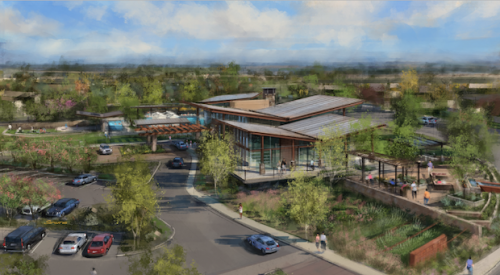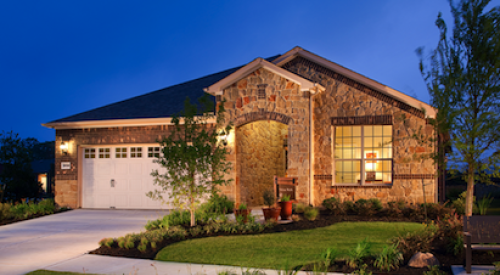|
In 1950, Bill Pulte built his first five-room home in Detroit and sold it for $10,000. Six years later, William J. Pulte, Inc. was formed. Now known as Pulte Homes, Inc., the company has grown to become the nation's largest home builder operating in 42 markets within 27 states and across 11 targeted consumer groups, and international operations in Mexico, Puerto Rico and Argentina. Pulte's ability to build and sell homes increases as the years go by with no end in sight. Total gross revenues for 2004 were $11.5 billion, up from $9 billion in 2003. "We're running this company for long-term success," states Richard J. Dugas, Jr., CEO and president of Pulte Homes. "We do a lot of investing for the long-term, and I don't just mean on our land propositions, although it's part of it. We also focus a lot on customer quality."
Pulte's approach to home building, focusing on consumer segmentation, acquisition costs relating to marketing through realtors and repeat referrals, and operational effectiveness, helped it reach top builder status for three years between 2000 and 2005. In 2004, J.D. Power and Associates named Pulte Homes the inaugural recipient of its Platinum Award for customer satisfaction among America's largest home building companies. Pulte divisions ranked highest in 14 markets, number two in nine markets and number three in six markets. Last year, Pulte Homes was the first national company to achieve the National Housing Quality (NHQ) Gold Award, patterned after the Malcolm Baldrige National Quality Award, by the Professional Builder and the NAHB Research Center.
Segmentation as a wholeWhat makes Pulte a market leader is its consumer segmentation model. According to Steve Petruska, executive vice president and Chief Operating Officer of Pulte Homes, in the 1990's Pulte started looking at consumers the way the rest of the world did by using a true segmentation of consumer segmented models. "We wanted to understand the behaviors and patterns that different consumers had with home buying," says Petruska. "But, what we didn't do very well until three or four years ago was being consistent across the company."
With the willingness to improve its building business, Pulte created a consumer segmentation model that's now used across the entire company. "It basically breaks the home buying consumers into 11 different targeted consumer groups (TCGs)," states Petruska.
The foundation for growth in building the company meant going after all 11 TCGs in every market. "What we saw was in any given market, we didn't have a market share that exceeded 10%," says Petruska. "We may have specialized in product for the entry-level consumer in market A, and we might have specialized in a move-up consumer in market B, but we didn't really look at all the opportunities to grow our business in any given market. Our segmentation model has given us the ability to slice and dice the data and the consumers in each market. Now we can identify the opportunities that we're missing."
When it's time to find new areas in which to target, Pulte researches the demand versus supply equation for every geographic sub-market of every city where it does business. "What we then try to do is invest in properties where demand exceeds supply," states Dugas. "It's this pinpoint accuracy that allows us to make good land investments from the beginning."
Beyond making key land investments, Pulte's segmentation model also allows it to better understand its customers and what they value in floor plans, special features as well as in community features. "We're able to get into detail on what specifications in the home they like," says Dugas.
Dugas points out one other key benefit from segmentation: Pulte has the largest universe of buyers to target for any national builder. "Since we're not putting all our eggs in just the entry-level basket, or the active adult basket, we have a very broad group of people to target in each city," says Dugas. "Our growth potential is the greatest among any large builder because we're not relying on any one consumer group to get all of our business."
Reputation brings lower customer acquisition costsPulte looks for its lower acquisition costs to come predominately from the realtor community (50% of sales are broker co-op sales) and repeat customer and referral business (currently 45% of sales).
Currently, "The cost of doing business with a realtor, when you look at it, is totally incremental business [dealing with a realtor]," says Petruska. "It's a lot less than trying to use a buckshot approach to advertising."
Repeat and referral business has increased over the past three years from approximately 25% to its current sales of 45%. "Forty-five percent of our buyers now say they bought from us because they heard about us from a friend or relative or they bought a previous Pulte home," states Petruska. "We think a lot of that is being driven by the reputation that we've earned through J.D. Power."
Power surveyed 25 markets in 2004 and Pulte builds in all but one of them. "The next closest national competitor only scored first place in three markets, so we had a sizable lead, says Dugas."
Operational excellenceReferred to as operational effectiveness by some builders, Pulte refers to its system of improving performance as operational excellence. "Some people might think it's about trying to save overhead dollars," says Petruska. "For us it's about trying to change the way we run the business."
Operational excellence has two sides — offensive and defensive. "The first is what we call the offensive reasons to simplify our business and to drive improvement," says Dugas. "This includes lowering costs on distribution of product, buying more efficiently and leveraging our buying power in an effort to save funds as part of our cost that gets sold on the house cost."
Dugas claims the defensive side is just as important as the offensive, if not more important. "Defensive means ensuring our production capability, given how competitive the home building industry is and the labor shortage that exists in this industry," says Dugas. "We think the builder in the future who's the easiest to do business with — not only from the consumer standpoint, but the contractor standpoint as well — is likely to be the winner."
"We don't want to miss 105 of our unit deliveries because we couldn't get our homes built on time," states Dugas. "The more complexity we add, the further we lengthen the building process and the tougher it gets to do business with us."
Operational excellence in the future at Pulte includes reducing the total number of floor plans the company offers; reducing the total SKUs used in the building process and moving toward even flow production.
"While we expect that these steps will start to contribute to cost saving in 2005 and 2006 (we estimate gross margin improvement of 40 bps [base points] improvement for 2005 and 23 bps for 2006), we believe the majority of the benefits of this strategy will come later, as Pulte moves to a high-velocity operation in 2007 and beyond," says analyst Margaret Whelan of UBS Investment Bank. "The effects of the efforts to simplify can be seen across all of Pulte's operations."
"We are really going after focused floor plans to targeted consumers," says Petruska. "We want to put out our best selling floor plans, ones that consumers have said over and over again, 'this floor plan works'."
Pulte has reduced the number of floor plans it offers by approximately 50% over the last 18 months from 2,200 to 1,250 by focusing on the most popular models. "The company plans to further reduce floor plans by another 50% by the beginning of 2006," says Whelan.
"We are really breaking down the process of building the home so the parts and pieces of the home go together easier," states Petruska. This includes value engineering as well as standardization of its specification process by targeted consumer groups.
Pulte is currently value engineering its remaining floor plans to find ways to reduce material and labor usage in its homes. With this practice in place, Pulte was able to save 21% in hard material costs, 10% in hard labor costs and 17% in truss costs. These continued efforts are what will keep Pulte in business for the long run.
|












